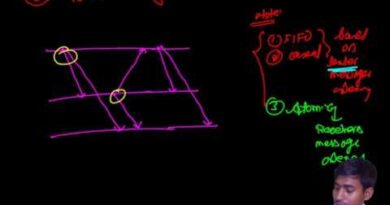An Introduction to Distributed Computing System with real examples.
An Introduction to Distributed Computing System with real examples.
Here’s a clear and concise introduction to Distributed Computing Systems along with real-world examples to help you understand the concept easily:
Contents [hide]
 Introduction to Distributed Computing System
Introduction to Distributed Computing System
 What is a Distributed Computing System?
What is a Distributed Computing System?
A Distributed Computing System (DCS) is a network of independent computers that work together to appear as a single system to the user. Each computer in the system (called a node) has its own memory and processor, and they communicate and coordinate with each other through a network to complete tasks.
 Key Characteristics:
Key Characteristics:
-
Multiple Independent Nodes – Computers connected via a network.
-
Resource Sharing – Hardware and software resources are shared.
-
Concurrency – Multiple processes run simultaneously.
-
Scalability – More nodes can be added to increase power.
-
Fault Tolerance – System can continue working even if one node fails.
 Why Use Distributed Computing?
Why Use Distributed Computing?
-
To handle large-scale tasks that a single machine cannot perform alone.
-
To ensure faster processing by dividing work.
-
To improve reliability and availability of services.
-
To allow geographically dispersed collaboration.
 Real-Life Examples of Distributed Computing Systems
Real-Life Examples of Distributed Computing Systems
 1. Google Search Engine
1. Google Search Engine
Google uses thousands of servers around the world. When you search for something, the query is processed across multiple data centers simultaneously to return fast and relevant results.
 2. Amazon Web Services (AWS)
2. Amazon Web Services (AWS)
AWS provides cloud computing services where your data and applications are managed across distributed servers located globally, ensuring high availability and performance.
 3. Online Multiplayer Games
3. Online Multiplayer Games
Games like PUBG or Fortnite run on distributed servers, handling millions of players across regions, managing real-time gameplay, matchmaking, and chat.
 4. Bitcoin & Blockchain
4. Bitcoin & Blockchain
Bitcoin is a distributed ledger system. All transactions are processed and verified by a network of distributed computers (miners), ensuring decentralization and security.
 5. Seti@Home or Folding@Home
5. Seti@Home or Folding@Home
These are scientific projects that use the idle processing power of thousands of home computers to analyze data related to space or protein folding (medical research).
 Types of Distributed Computing Architectures
Types of Distributed Computing Architectures
-
Client-Server Model
-
Clients request services, servers provide them (e.g., web servers).
-
-
Peer-to-Peer Model (P2P)
-
Every node can act as both a client and server (e.g., BitTorrent).
-
-
Multitier Architecture
-
Applications are split into tiers: presentation, logic, and data (e.g., modern web apps).
-
 Advantages of Distributed Systems
Advantages of Distributed Systems
-
Increased performance
-
Greater reliability
-
Better resource utilization
-
Easier scalability
-
Geographical distribution of resources
 Challenges in Distributed Systems
Challenges in Distributed Systems
-
Synchronization of processes
-
Security risks
-
Network latency
-
Fault handling
-
Data consistency
 Conclusion:
Conclusion:
A Distributed Computing System is essential in today’s data-driven, globalized world. From cloud services to cryptocurrencies, distributed systems are everywhere, enabling speed, scale, and reliability in ways that single-computer systems never could.
Would you like this as a presentation, PDF handout, or expanded into a full assignment or essay format?



